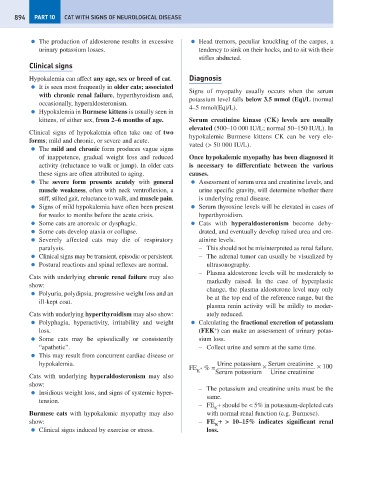Page 902 - Problem-Based Feline Medicine
P. 902
894 PART 10 CAT WITH SIGNS OF NEUROLOGICAL DISEASE
● The production of aldosterone results in excessive ● Head tremors, peculiar knuckling of the carpus, a
urinary potassium losses. tendency to sink on their hocks, and to sit with their
stifles abducted.
Clinical signs
Hypokalemia can affect any age, sex or breed of cat. Diagnosis
● It is seen most frequently in older cats; associated
Signs of myopathy usually occurs when the serum
with chronic renal failure, hyperthyroidism and,
potassium level falls below 3.5 mmol (Eq)/L (normal
occasionally, hyperaldosteronism.
4–5 mmol(Eq)/L).
● Hypokalemia in Burmese kittens is usually seen in
kittens, of either sex, from 2–6 months of age. Serum creatinine kinase (CK) levels are usually
elevated (500–10 000 IU/L; normal 50–150 IU/L). In
Clinical signs of hypokalemia often take one of two
hypokalemic Burmese kittens CK can be very ele-
forms; mild and chronic, or severe and acute.
vated (> 50 000 IU/L).
● The mild and chronic form produces vague signs
of inappetence, gradual weight loss and reduced Once hypokalemic myopathy has been diagnosed it
activity (reluctance to walk or jump). In older cats is necessary to differentiate between the various
these signs are often attributed to aging. causes.
● The severe form presents acutely with general ● Assessment of serum urea and creatinine levels, and
muscle weakness, often with neck ventroflexion, a urine specific gravity, will determine whether there
stiff, stilted gait, reluctance to walk, and muscle pain. is underlying renal disease.
● Signs of mild hypokalemia have often been present ● Serum thyroxine levels will be elevated in cases of
for weeks to months before the acute crisis. hyperthyroidism.
● Some cats are anorexic or dysphagic. ● Cats with hyperaldosteronism become dehy-
● Some cats develop ataxia or collapse. drated, and eventually develop raised urea and cre-
● Severely affected cats may die of respiratory atinine levels.
paralysis. – This should not be misinterpreted as renal failure.
● Clinical signs may be transient, episodic or persistent. – The adrenal tumor can usually be visualized by
● Postural reactions and spinal reflexes are normal. ultrasonography.
– Plasma aldosterone levels will be moderately to
Cats with underlying chronic renal failure may also
markedly raised. In the case of hyperplastic
show:
change, the plasma aldosterone level may only
● Polyuria, polydipsia, progressive weight loss and an
be at the top end of the reference range, but the
ill-kept coat.
plasma renin activity will be mildly to moder-
Cats with underlying hyperthyroidism may also show: ately reduced.
● Polyphagia, hyperactivity, irritability and weight ● Calculating the fractional excretion of potassium
+
loss. (FEK ) can make an assessment of urinary potas-
● Some cats may be episodically or consistently sium loss.
“apathetic”. – Collect urine and serum at the same time.
● This may result from concurrent cardiac disease or
hypokalemia. Urine potassium × Serum creatinine
FE + % = × 100
K Serum potassium Urine creatinine
Cats with underlying hyperaldosteronism may also
show:
– The potassium and creatinine units must be the
● Insidious weight loss, and signs of systemic hyper-
same.
tension.
–FE + should be < 5% in potassium-depleted cats
K
Burmese cats with hypokalemic myopathy may also with normal renal function (e.g. Burmese).
show: – FE + > 10–15% indicates significant renal
K
● Clinical signs induced by exercise or stress. loss.

